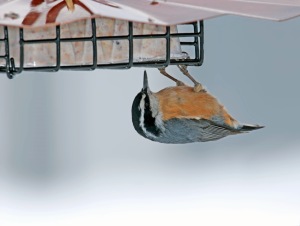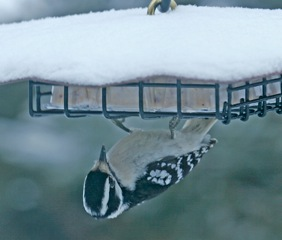With the winter approaching, birds need a higher fat diet in order to endure the colder temperatures. Here in Michigan at Wild Birds Unlimited of GPW, we are ready with a stockpile of suet to help. This is the time of year to beef up your wild bird feeding station – literally!
Beef fat, or suet, has been a favorite winter-feeding strategy for those who love to watch the birds. Pure rendered beef fat is great to use when you can’t keep the squirrels out of the suet feeder. Without added nuts or seeds, the pure suet isn’t high on the list of a squirrel’s priorities for food.
If you can place a suet feeder out of the reach of squirrels, you can offer suet with peanuts or seed added to the formed cake of fat. Squirrel-proof can be obtained if the feeder is placed on a pole system with a baffle top at five feet above ground and the set-up eight feet away from any leaping opportunity. You’ll find that the woodpeckers. Chickadees and nuthatches in your yard will visit both pure and enhanced suet, with an emphasis on eating the high fat nuts when the weather is colder. Some suet will have fruit, which is attractive to red-bellied woodpeckers.
There is also a hot pepper version of suet, meant as a squirrel deterrent, since mammals have more taste buds than birds and find the hot pepper distasteful. The birds don’t detect the hot flavoring, allowing you to place the suet feeder in any location for viewing.
If European Starlings become a persistent problem, try hanging your feeders so that they are oriented with access only from the bottom. There are a number of feeders that are made specifically for this purpose. The Starling Stumper, when added to your current suet cage feeder, accomplishes this goal as well.
When birds eat suet, they stay at the feeder for a longer period of time, allowing you to appreciate their crisp colors in the bright sun of winter. Gone are the old feathers that were worn from the rigors of rearing a family or two. The fall molt has provided them with a new set of feathers, including an extra amount for warmth.
Feeding suet in the fall and winter is one of the most enjoyable ways to watch birds in your yard.
Enjoy your birds!


